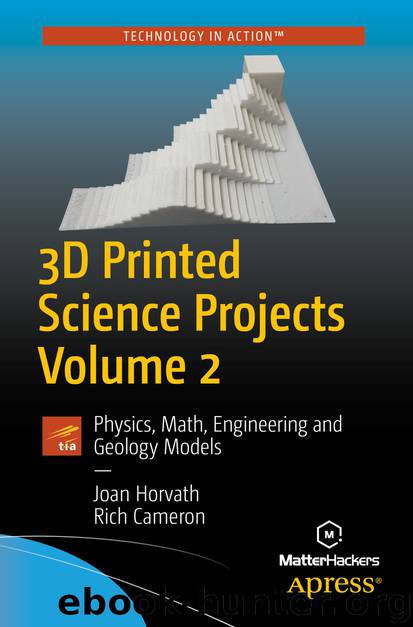3D Printed Science Projects Volume 2 by Joan Horvath & Rich Cameron

Author:Joan Horvath & Rich Cameron
Language: eng
Format: epub
Publisher: Apress, Berkeley, CA
Simplest Approximation: Pennies as Point Masses
For a first cut at figuring out the center of mass, we will treat the pennies as point masses at their centers. A point mass contributes its mass times the square of its radius from the center of mass of the overall object to the moment of rotational inertia. Later we give suggestions for doing this more accurately, but for now we want to give a rough idea about how to get started.
We used 39 pennies for our experiments, 13 in each of the sets of 3 holes. We measured the mass as 100 grams total. As noted in Chapter 1, some pennies are 3 g and some are 2.5, depending on when they were minted (they were heavier before 1982). We felt that just weighing them was a simple measurement and would allow for wear. All the holes are 20 mm in diameter, just a bit bigger than the 19.5 mm diameter of a penny.
The centers of the outer penny holders are 0.1 cm plus 10 cm in from the outside of the wheel’s 5 cm radius; that works out to 5 – 0.1 – 1 = 3.9 cm. The additional rotational moment of inertia for pennies in the outer ring is thus 100 g * (3.9 cm)2, or 1521 g-cm2. The overall moment of inertia for the empty wheel plus pennies in the outer circle of holes is 575 + 1521 = 2096 g-cm2.
The center of the inner ring of three pennies are halfway between the outer penny holders and the hole at the center of the wheel; that is, 1.95 cm. So, the additional rotational moment of inertia added by pennies in the inner ring is 100 g * (1.95 cm)2, or 380 g-cm2, making the overall moment of inertia for the empty wheel plus pennies on the inner circle of holes 575 + 380 = 955 g-cm2.
Finally, we placed 13 pennies in the central hole; we used 100 / 3 grams as the mass for this. If we are treating the pennies as a point mass at the center, the moment of inertia does not change and is the same as the empty wheel, or 575 g-cm2. The mass, though, is different. Table 5-1 sums up these results.Table 5-1. Moment of Inertia for Three Cases
Download
This site does not store any files on its server. We only index and link to content provided by other sites. Please contact the content providers to delete copyright contents if any and email us, we'll remove relevant links or contents immediately.
Kathy Andrews Collection by Kathy Andrews(11726)
The remains of the day by Kazuo Ishiguro(8817)
Paper Towns by Green John(5087)
Spare by Prince Harry The Duke of Sussex(5071)
The Body: A Guide for Occupants by Bill Bryson(4973)
Industrial Automation from Scratch: A hands-on guide to using sensors, actuators, PLCs, HMIs, and SCADA to automate industrial processes by Olushola Akande(4970)
Machine Learning at Scale with H2O by Gregory Keys | David Whiting(4169)
Be in a Treehouse by Pete Nelson(3941)
Never by Ken Follett(3787)
Harry Potter and the Goblet Of Fire by J.K. Rowling(3772)
Goodbye Paradise(3724)
Into Thin Air by Jon Krakauer(3308)
The Remains of the Day by Kazuo Ishiguro(3293)
The Cellar by Natasha Preston(3259)
The Genius of Japanese Carpentry by Azby Brown(3223)
Fairy Tale by Stephen King(3216)
120 Days of Sodom by Marquis de Sade(3177)
Drawing Shortcuts: Developing Quick Drawing Skills Using Today's Technology by Leggitt Jim(2996)
The Man Who Died Twice by Richard Osman(2995)
